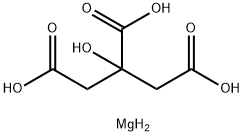Trimagnesium dicitrate
- CAS NO.:3344-18-1
- Empirical Formula: C6H10MgO7
- Molecular Weight: 218.44
- MDL number: MFCD00036422
- EINECS: 222-093-9
- SAFETY DATA SHEET (SDS)
- Update Date: 2024-10-25 16:21:11

What is Trimagnesium dicitrate?
Absorption
Mean plasma concentration of magnesium after administration of oral doses of magnesium citrate are reported to be of around 0.7 mmol/L and the concentration in saliva rested in 0.28 mmol/L. In reports, it has also been proven that the absorption and bioavailability of magnesium are greater when administered in the form of magnesium citrate when compared with other forms such as magnesium ocude.
Toxicity
The occurrence of overdose with magnesium citrate is very unlikely but some of the signs of the presence of overdose are diarrhea or severe stomach pain.
Chemical properties
White or slightly yellow granules powder
The Uses of Trimagnesium dicitrate
Trimagnesium Dicitrate is used in preparation of Cyclopentadiene Magnesium Ferrite nano material
The Uses of Trimagnesium dicitrate
Laxative .
Indications
Magnesium citrate has been used in bowel preparations prior to a colonoscopy as a cathartic agent.
It is also used in over-the-counter products to relieve occasional constipation.
Magnesium citrate can be one of the forms used for the administration of dietary supplements.
Background
Magnesium citrate is a low volume and osmotic cathartic agent. The cathartic action works primarily through the high osmolarity of the solution which draws large amounts of fluid into space where is used. Magnesium citrate is considered by the FDA as an approved inactive ingredient for approved drug products under the specifications of oral administration of a maximum concentration of 237 mg. It is also considered as an active ingredient in over-the-counter products.
Definition
ChEBI: A magnesium salt composed of magnesium and citrate ions in a 3:2 ratio.
Flammability and Explosibility
Non flammable
Pharmacokinetics
The onset of action can be as early as 30 minutes after administration with a mean onset time of approximately 2 hours and a maximum action of 4 hours. The effect of magnesium citrate is highly dependent on the individual's hydration status.
Metabolism
Not Available
Properties of Trimagnesium dicitrate
| storage temp. | Sealed in dry,Room Temperature |
| solubility | Soluble in water, practically insoluble in ethanol (96 per cent). It dissolves in dilute hydrochloric acid. |
| form | Powder |
| color | White to off-white |
| Odor | Odorless |
| Water Solubility | Slightly soluble in water. |
| Merck | 14,5663 |
| CAS DataBase Reference | 3344-18-1(CAS DataBase Reference) |
Safety information for Trimagnesium dicitrate
Computed Descriptors for Trimagnesium dicitrate
Trimagnesium dicitrate manufacturer
Vasa Pharmachem Pvt Ltd. (VPPL)
New Products
(S)-3-Aminobutanenitrile hydrochloride 4-Methylphenylacetic acid N-Boc-D-alaninol N-BOC-D/L-ALANINOL Tert-butyl bis(2-chloroethyl)carbamate 3-Morpholino-1-(4-nitrophenyl)-5,6-dihydropyridin- 2(1H)-one Furan-2,5-Dicarboxylic Acid Tropic acid 1-Bromo-3,5-Di-Tert-Butylbenzene S-2-CHLORO PROPIONIC ACID ETHYL ISOCYANOACETATE 2-Bromo-1,3-Bis(Dimethylamino)Trimethinium Hexafluorophosphate 4-IODO BENZOIC ACID 3-NITRO-2-METHYL ANILINE 1-(2,4-DICHLOROPHENYL) ETHANAMINE (2-Hydroxyphenyl)acetonitrile 4-Bromopyrazole 2-(Cyanocyclohexyl)acetic acid 4-methoxy-3,5-dinitropyridine 1-(4-(aminomethyl)benzyl)urea hydrochloride 2-aminopropyl benzoate hydrochloride diethyl 2-(2-((tertbutoxycarbonyl)amino) ethyl)malonate tert-butyl 4- (ureidomethyl)benzylcarbamate Ethyl-2-chloro((4-methoxyphenyl)hydrazono)acetateRelated products of tetrahydrofuran








You may like
-
 Magnesium citrate hydrate CAS 3344-18-1View Details
Magnesium citrate hydrate CAS 3344-18-1View Details
3344-18-1 -
 Magnesium citrate hydrate CAS 3344-18-1View Details
Magnesium citrate hydrate CAS 3344-18-1View Details
3344-18-1 -
 Magnesium citrate, 98% CAS 3344-18-1View Details
Magnesium citrate, 98% CAS 3344-18-1View Details
3344-18-1 -
 MAGNESIUM CITRATE HYDRATE Extra Pure CAS 3344-18-1View Details
MAGNESIUM CITRATE HYDRATE Extra Pure CAS 3344-18-1View Details
3344-18-1 -
 Magnesium citrate hydrate 98% CAS 3344-18-1View Details
Magnesium citrate hydrate 98% CAS 3344-18-1View Details
3344-18-1 -
 Magnesium citrate CAS 3344-18-1View Details
Magnesium citrate CAS 3344-18-1View Details
3344-18-1 -
 14714-50-2 (2-Hydroxyphenyl)acetonitrile 98+View Details
14714-50-2 (2-Hydroxyphenyl)acetonitrile 98+View Details
14714-50-2 -
 118753-70-1 98+View Details
118753-70-1 98+View Details
118753-70-1